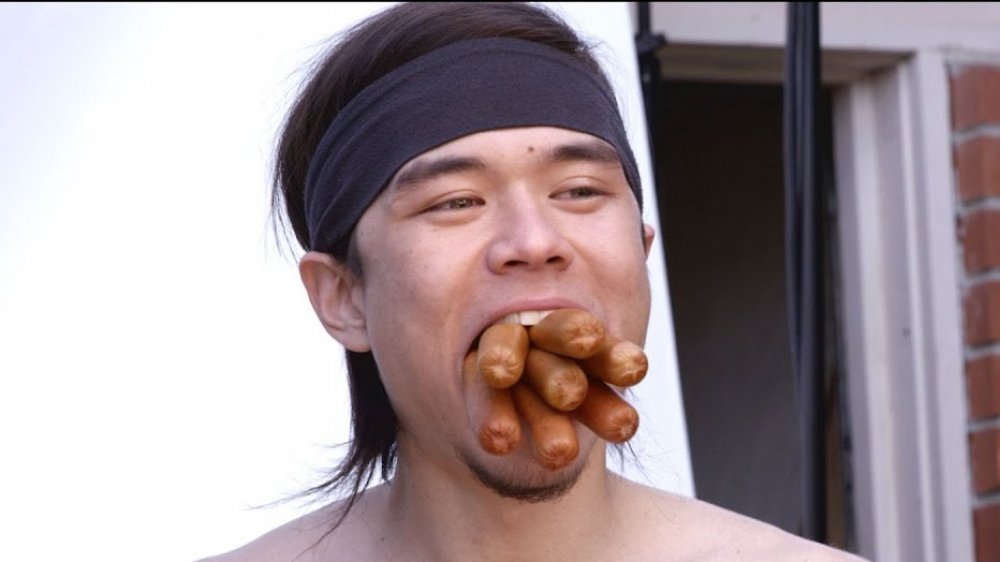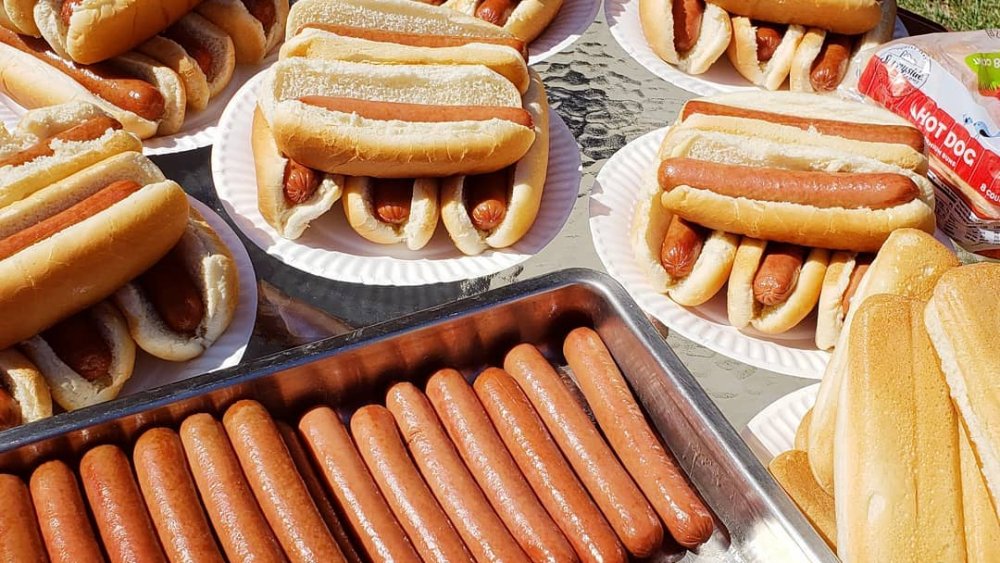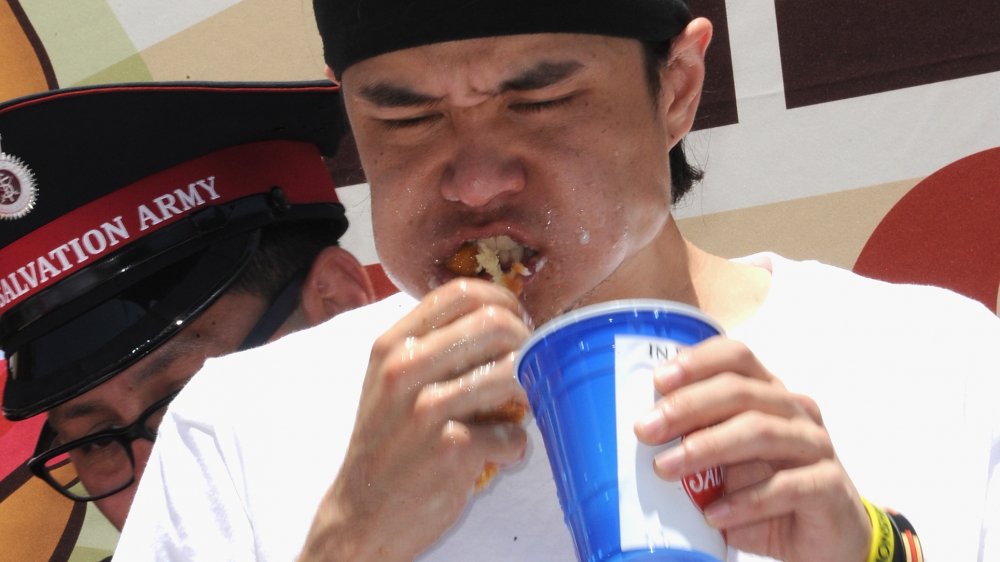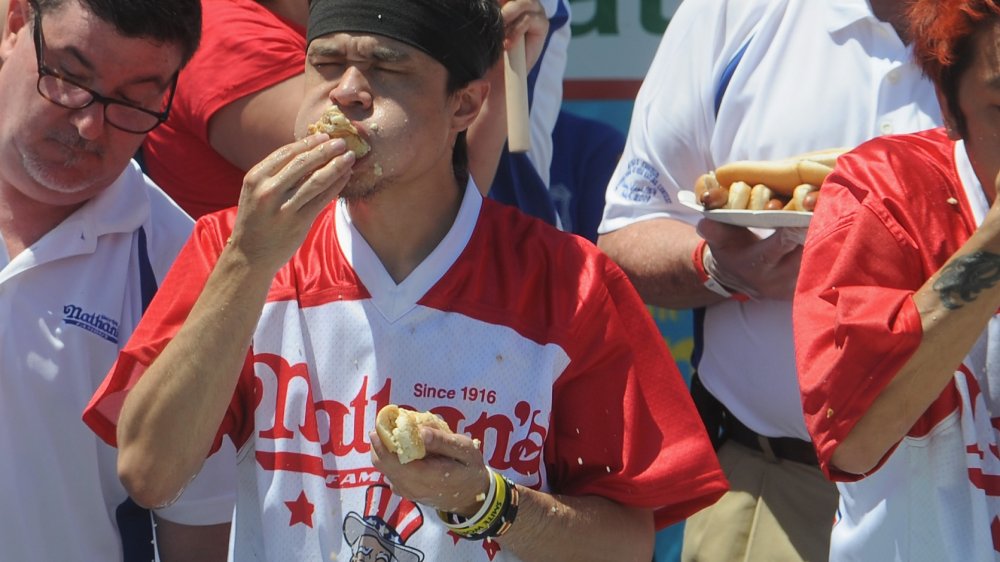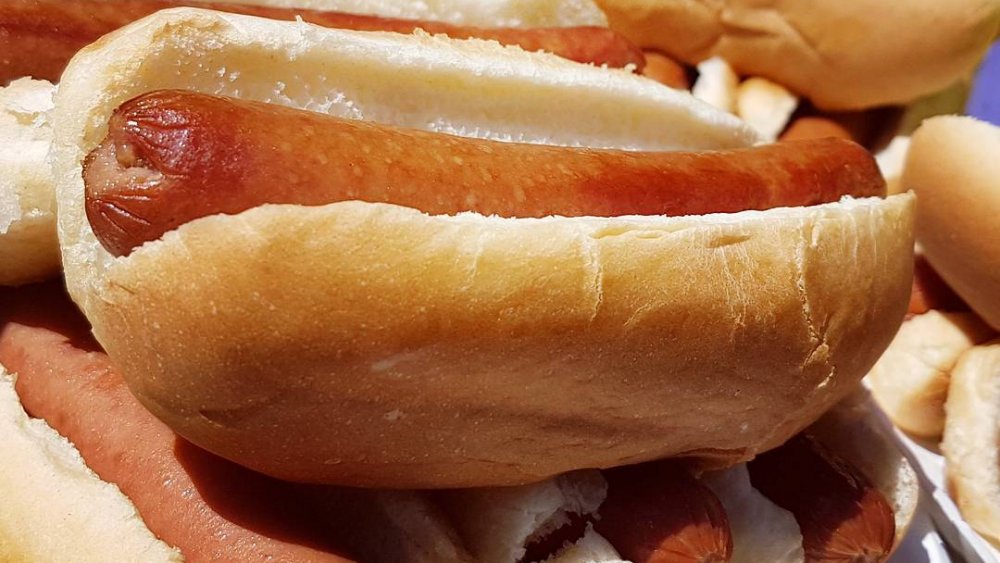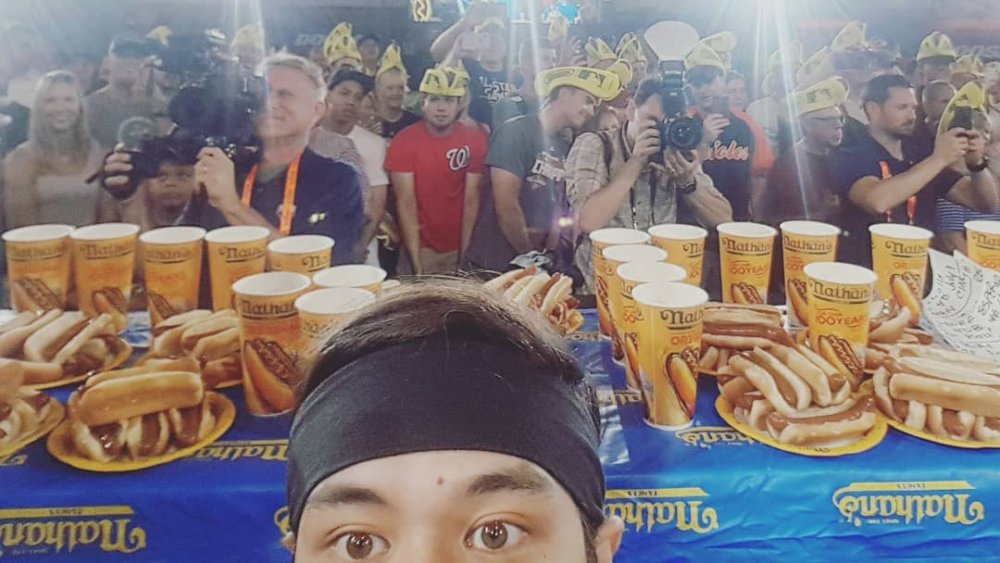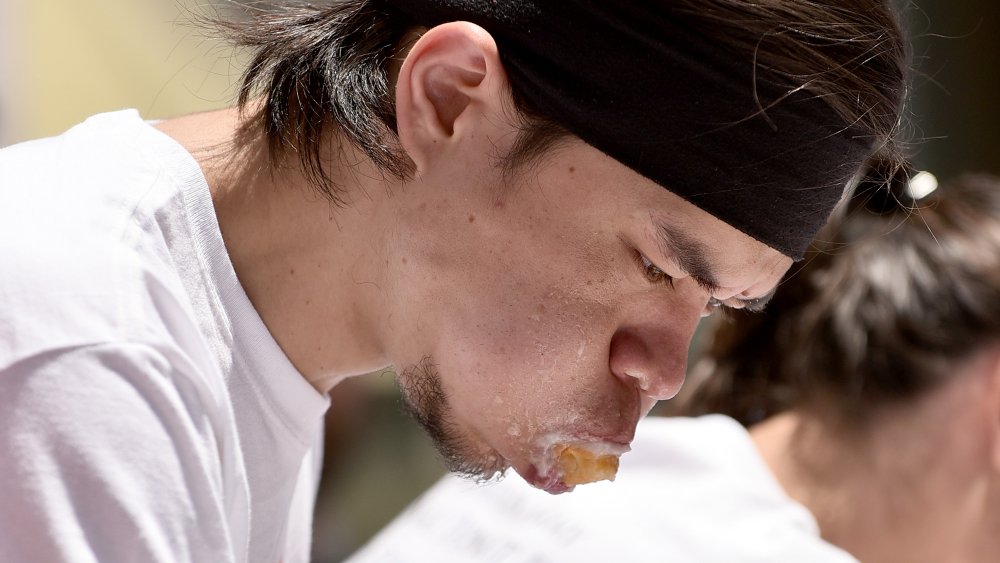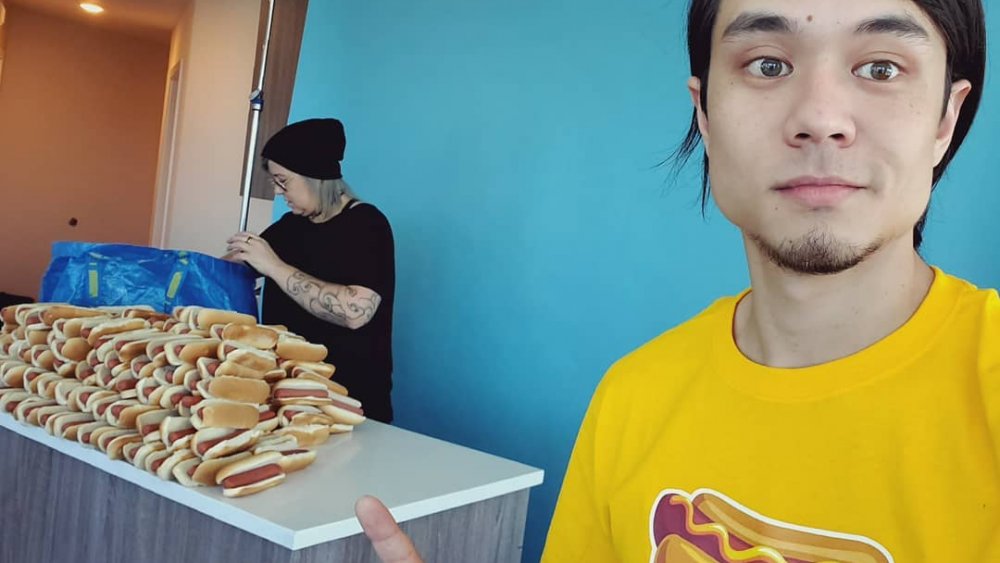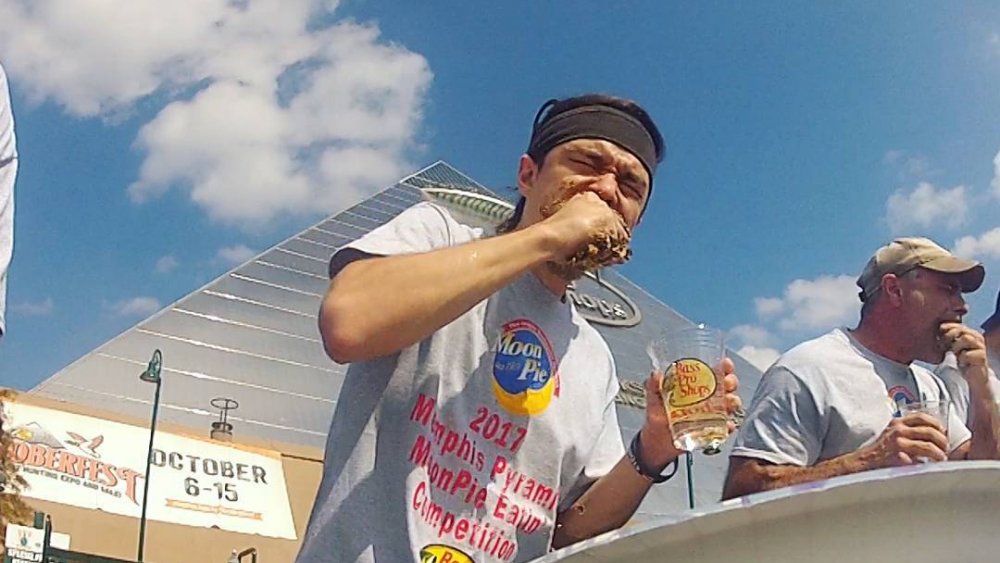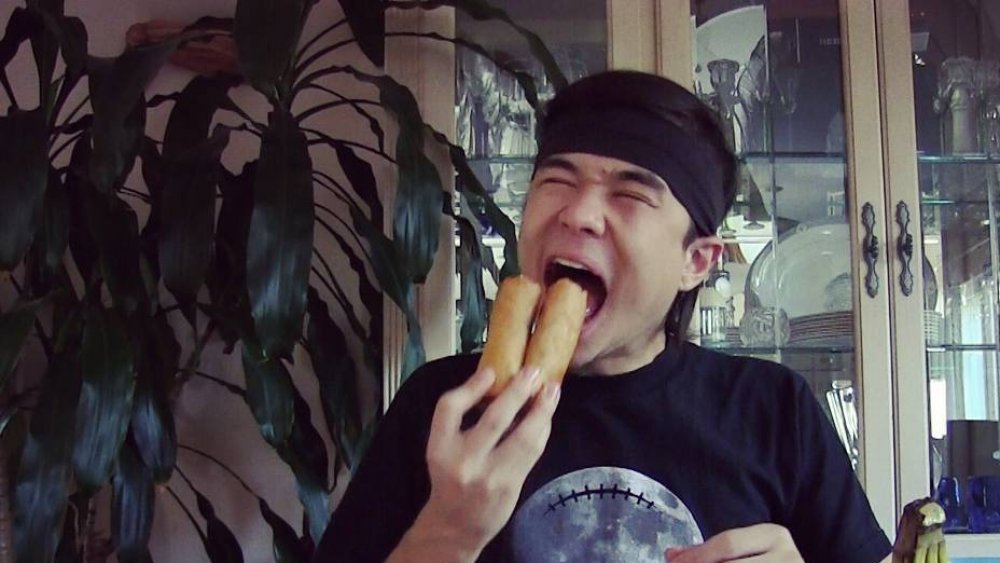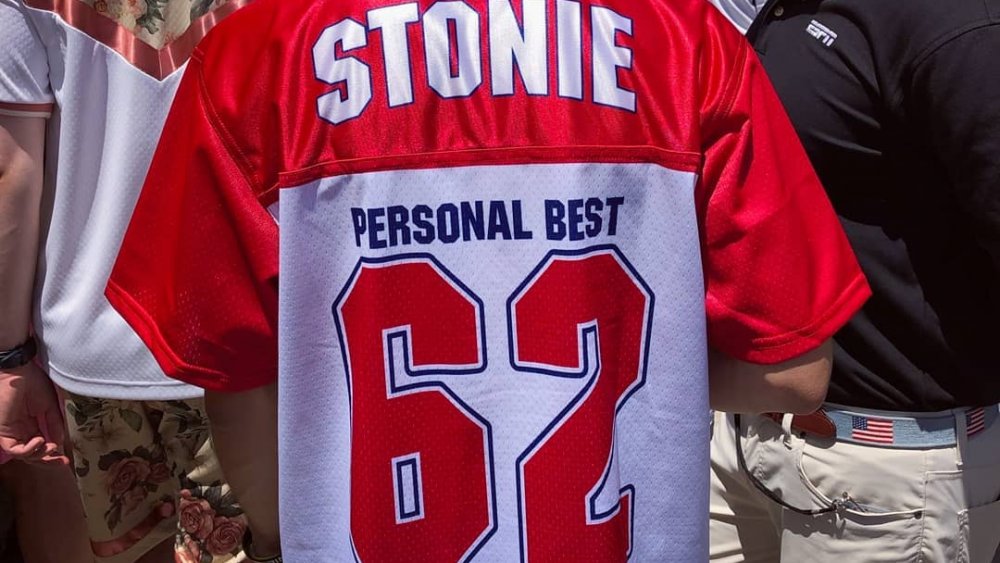How To Eat A Hot Dog Like Matt Stonie
Eating two or three hot dogs in a sitting is enough to make most people feel like they need to take a break from the family cookout... but Matt Stonie is not "most people." Matt Stonie is a professional competitive eater and member of Major League Eating — an organization that hosts a circuit of speed-eating contests, including the world-famous Nathan's Famous Hot Dog Eating Contest held each year on July 4th and broadcasted live by ESPN.
In 2015, Matt Stonie unseated perennial hot-dog-eating champion (and current World Record Holder), Joey Chestnut, when he sucked down 62 hot dogs in just 10 minutes. Granted, Chestnut took back his trophy the next year (and every year since), but it was this unexpected win that helped put Stonie on the map and ratcheted up his fame, making him one of the most recognizable faces in the sport. As of June 2020, Stonie was ranked third in the world in Major League Eating, but in popularity? He's hands-down the most popular speed-eater, with more than 11 million YouTube subscribers. These fans tune in each month to watch him tackle ridiculous eating challenges, like downing massive bowls of Fruit Loops, or giant bags of Sour Patch Kids. As a result, if you're trying to learn to eat a hot dog like a true champion, Matt Stonie is probably the best teacher you could hope to find. Here are some of his best tips for taking your summer eating celebrations to the next level.
Start training well in advance
According to a 2015 USA Today article, George Shea, one of the founders of Major League Eating, insisted there was no reason to train for competitive eating contests, stating for the publication, "It's ridiculous. You don't need to do it. There's no arms race to 100 (hot dogs)."
The problem, of course, is that people are naturally competitive. And when there's money to be won (as of 2019, the purse for the Nathan's hot dog competition was $10,000 for the winner), competitors will do what they need to do to go home with the prize. In the case of Stonie? In the same USA Today article, Stonie admitted to starting to train for the hot dog contest about six weeks in advance, consuming up to 60 hot dogs a day, three times a week. If you think about it, that type of intense training schedule isn't all that different from people who train for other sports. The only difference, is that competitive eaters are training their stomachs to expand to accept more food in a single sitting, rather than training their bodies to perform in other ways.
Drink lots of water to expand your stomach
Another common practice that competitive eaters use while training for big events is to drink what (many people) would consider excessive, if not downright dangerous, amounts of water in the days and weeks leading up to a big event. The 2015 USA Today article pointed out that Stonie, while training for an event, often drinks up to a gallon of water after eating an obscene amount of food. He admitted that trying to force down this amount of water, especially after having eaten enough food to feed a family for days, makes him feel like he's going to explode, further stating, "It's pushing your limits."
Which is pretty much a giant understatement.
While drinking water in this fashion is common within the sport, it's not advisable. Another competitive eater — Dave Brunelli — who spoke about his training to USA Today said he no longer drinks more than a gallon of water during each training session because doing so often left him feeling dizzy for weeks. This type of dizziness can be a sign of a dangerous sodium imbalance called hyponatremia, which can lead to seizures, coma, or death. All-in-all, forcing down water to expand your stomach may technically work if you're trying to eat 62 hot dogs in 10 minutes like Matt Stonie, but it's not exactly good for your health.
Use both hands to get those hot dogs down
The trick to stuffing down dozens of hot dogs in a single sitting, especially when your time is restricted, is to work as efficiently as possible. Both hands have to be active to help you get the food in your mouth while also preparing the next dog for consumption. In a YouTube video made by Matt Stonie, he talks about the importance of using both hands to increase efficiency. The technique changes slightly depending on the food you're eating but in the case of hot dogs, the most popular techniques are the "Soloman Technique" and the "Two-Meat, Two-Bun" technique.
In both cases, you end up using one hand to stuff the meat in your mouth, and the other hand to dunk the buns in water before shoving them in your mouth, too. Then, you trade-off between grabbing more hot dogs from the buns and grabbing the buns to dunk in the water. This creates a continuous hot dog-eating cycle, with each hand in charge of its own job.
Separate the hot dog from the bun
As discussed in Matt Stonie's hot-dog-eating YouTube tutorial, there are really only two popular styles for eating this summer favorite in a contest — the Soloman Technique and the Two-Meat, Two-Bun technique. In both versions, competitors remove the hot dogs from the buns before stuffing their faces. In the case of the Soloman Technique, one hot dog is removed from its bun, then the hot dog is broken in half and eaten first (both halves stuffed in the mouth at the same time). Then, as soon as the meat is swallowed down, the competitor follows up by eating the bun.
The Two-Meat, Two-Bun technique that Stonie subscribes to is essentially the same but involves removing two hot dogs from their buns and eating them simultaneously (without breaking them in half first), quickly followed by the buns. The argument is that, while it's harder to get good at this 2/2 technique, and it increases the risk of choking by trying to eat so much meat at once, overall it's the most efficient way to eat hot dogs fast. For well-trained competitors, it requires fewer hand movements (increasing overall efficiency).
Dunk the hot dog buns in water
The water set out for competitive eaters during a hot dog eating contest isn't there for hydration purposes — it's there as a tool for lubrication to help make the hot dogs and the buns go down quicker. And as unappealing (and by unappealing, we mean disgusting) as consuming 60 to 70 soggy hot dog buns sounds, can you imagine trying to eat that many hot dog buns dry? It would be so much worse. And dangerous, frankly — a dry, crumby bun would be a lot easier to choke on. And certainly, no one would be downing 60 to 70 dry buns in 10 minutes.
As Matt Stonie points out in a hot dog eating YouTube tutorial, by dunking the buns in water before putting them in your mouth, you make it possible to eat the buns faster — almost no chewing is required. Plus, the water in the buns helps any leftover pieces of meat slide down your throat a bit easier. Efficiency is a competitive eater's best friend, and this technique maximizes efficiency. Stonie explains that while hot dogs require lots of chewing, soggy buns do not. When you separate the hot dog from the bun, you can chew the hot dog first, then consume the water-logged bun with little to no chewing, both giving your jaws a brief break, and decreasing the total amount of chewing required for a single hot dog/bun combo.
Work on your breathing rhythm
You'd be surprised how important breathing is for competitive eating. It's one of those common-sense realities that you may not consider until you're in the trenches of stuffing your face. In a 2016 interview with Matt Stonie published in Toronto Life, the professional eater said, "Pay attention to your breathing or you'll suffocate while eating, and that will slow you down."
While Stonie recognizes the importance of breathing to success in the sport, he doesn't expand on how to pay attention to your breathing. Another competitive eater, Yasir Salem, pointed out that learning to swim actually helped him become a better professional eater. In an interview with Mental Floss in 2015, he explained, "In swimming, there's a rhythm to breathing. You have to understand you're going to breathe every two or three strokes... There's a similar rhythm in eating," Salem said. "Maybe you breathe every hot dog or every two hot dogs. But you need to figure out your rhythm and stick to it."
The competitive eater pointed out that failure to master your breathing can result in a serious loss in time because you'll be constantly taking a step back to grab your breath and bring your heart rate down. "When you're talking like 25, 30 hot dogs, and you're breaking every three or four hot dogs for 30 seconds, that's 30 percent of the contest," Salem explained. "You don't have that time to waste."
Wearing comfortable clothes is key
Most competitive eaters don't come right out and say that comfy clothes are the unofficial uniform of the sport, but you don't see Matt Stonie show up for the Nathan's Famous Hot Dog Eating Contest in a three-piece suit, now do you? Of course not. You see him in workout shorts and an oversized t-shirt, or maybe some sweats. The concept is akin to that at Thanksgiving — when you know you're about to stuff yourself, you don't want the biofeedback from your clothing reminding you that everything about what you're doing is uncomfortable.
Most speed-eating competitions provide entrants with T-shirts to commemorate the experience, so your best go-to garb when you're about to chow down is whatever feels most comfortable. Stonie also points to his headband as his secret weapon. In one YouTube video where he tries to teach his brother to speed eat, he states, "Everybody knows that half of my eating abilities come from the fact that I wear a headband." That may not be entirely true (let's be real, it's almost absolutely false), but hey, if it gives you a little extra confidence, or keeps your hair out of your eyes (and your mouth) as you stuff your face, why not give it a try?
Stay on your feet while you eat
You never see a competitive eater sitting down on the job. Sure, maybe for a YouTube video, especially if the eating challenge isn't timed, but in an actual competition? All the competitors are standing. The simple explanation is that when you sit down, your torso compresses and it's harder to take advantage of all the space in your abdomen. According to a 2017 article published on 5 On Your Side, a normal stomach is about the size of a Nerf football and can expand, at most, approximately 15 percent. So, think about how you feel when you gorge yourself on Thanksgiving Day — that might be the extra 15-percent expansion. But competitive eaters like Matt Stonie have trained their stomachs to expand two to three times their normal size.
Imagine that for a moment: If your stomach is normally the size of a single Nerf football, during a competition, a speed-eater needs their stomach to grow to the size of two or three Nerf footballs. It's going to be a whole lot harder to achieve this extra expansion if you're sitting down with your torso hunched over. Thus, standing is key. And while Matt Stonie doesn't come right out and give the tip as such, his YouTube videos make it clear — when trying to teach his brother to speed eat, they went from sitting on a couch to standing up at a table when they got serious about improving technique.
Move around while eating hot dogs
Standing up is one of the first "tricks" competitive eaters use to efficiently expand their stomachs during competition and maximize the volume of food they can force into their abdomens, but you'll rarely witness a competitive eater standing still. When you see eaters jumping up and down, wriggling, or simply shifting their weight from side to side during a contest, they're trying to help gravity along by using their own movements to increase the speed of the food entering the stomach, encouraging it to "settle" as much as possible.
In a YouTube tutorial on Matt Stonie's channel, the champion eater said, "I can't imagine standing still when eating 10 to 15 pounds of food. If I feel a burp coming up, or I'm just feeling a little uncomfortable... I'll give myself a jump, make gravity work for me, push it down, maybe give it a little shake. It helps the gas kinda move up and the food settle down a little bit more. You'd be surprised how much it helps."
Stonie subscribes to his "jump, push it down, and shake" method, but again, these movements are really a matter of personal choice. Just like football players come up with their own touchdown dances, competitive eaters come up with their own movements. Experiment. Make the sport your own. Find out what works for you.
Chew the hot dogs as little as possible
If efficiency and speed are the secrets to successful hot dog eating, it's important to chew as little as possible. This is tricky with hot dogs because if you don't chew enough, you'll end up choking. But if you spend too much time chewing, you'll hurt your chances of a win. In an interview with Toronto Life in 2016, Matt Stonie stated, "Don't chew too much, and focus on your swallowing instead. You don't want to choke, so you do have to chew, but if you chew too much it makes your jaw tired and it slows you down."
This, of course, takes practice. And it's one of the reasons it's important to separate the hot dogs from the buns before trying to eat them. This way, you can focus first on eating the hot dogs and chewing them sufficiently without also having to focus on chewing the buns. Then, you can use the soggy buns to reduce the chewing of the buns while also helping wash down any remaining meat.
Find what works for you and experiment
The world of competitive eating is still relatively new. While an article in Time points out that eating contests have been around for at least 100 years, it's only existed as a "sport" since the mid-90s when its governing body, Major League Eating was founded. As such, many competitors are just trying to experiment and figure out what works best for them. For instance, in a 2015 USA Today article, Stonie himself stated, "A lot of us don't know what we're doing... We're just experimenting."
Part of experimenting is figuring out what works. In a hot-dog-eating YouTube tutorial, Stonie points out how helpful it is to figure out which hand you feel most comfortable dunking your hot buns with, and which hand you feel most comfortable eating the hot dogs with. Unsurprisingly, the answer varies from person to person. Likewise, many competitive eaters test different techniques, develop their own habits for moving around, and try to figure out how much water to leave in the bun before shoving it in their mouth. Too much water takes up extra space in your stomach. Too little? You'll have to chew more and risk choking on crumbs.
The long-and-short of it is that competitive hot dog eating is as much of an art as it is a science. And while some tips are universally adopted (like standing up while eating), there's still a lot of room to experiment and develop your own training regimen and techniques.
